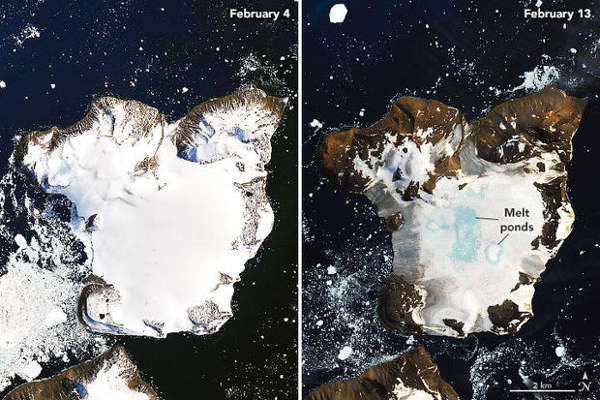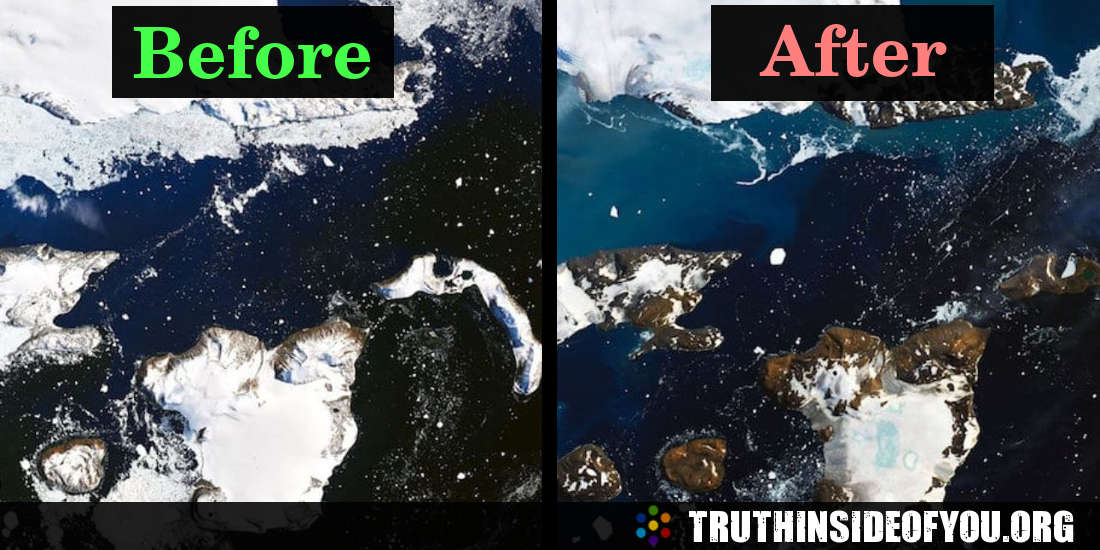Antarctica saw a sharp rise in temperature as it touched 64.9 degrees Fahrenheit, earlier in February 2020.
This is the highest temperature so far recorded in the continent, equivalent to that of Los Angeles on the same day. NASA has released pictures that show the ice melting rapidly due to this sudden heatwave. This phenomenon has become commonplace in the Antarctic Peninsula now.
The Earth Observatory of NASA captured 2 pictures and sent it via Landsat 8’s Operational Land Imager on Friday. The image shows the difference in the appearance of the Eagle Island ice cap on 2 days- 4th and 13th February.
A huge decrease in the amount of snow and ice can be seen along the Antarctic Peninsula’s northern tip. In the latter image, blue-colored melted ponds can be seen and also the ground has been exposed.

The Eagle Island and research base in Esperanza, Argentina are approximately 25 miles apart. On 6th February, the base noticed the record-breaking high temperature. The climate model of NASA reveals that the island saw the highest melting (approximately an inch) on this day. Over the whole week, a total of four inches of snow melted.
NASA informed that the Island lost about 20% of its seasonal snow accumulation during this event. Mauri Pelto is a glaciologist who said that such events are common in Greenland and Alaska but not in Antarctica.
Pelto added that such an intense melting event can only happen when the temperature has been consistently above the freezing temperature. This is something no one had heard of until now but in the twenty-first century, it’s becoming common. What’s more alarming is that such events are happening more frequently now.

The World Meteorological Organization (WMO) is yet to verify this temperature record. But it has recognized the Peninsula as becoming warmer at a faster rate.
This event was a result of unusual weather patterns in the South American coast. A high pressure formed over Cape Horn in Chile caused the rise in temperature. Strong winds generally keep the warm air at bay but the weak Westerlies allowed this warm air to get to the ice caps.
This month’s heat pattern is a cause of concern as it was 3rd such an event. The 2 other such heat waves occurred in November 2019 and January 2020.
Recently, warm water was found below the “doomsday glacier”, another first for the continent. If a 74,000 sq. mile Thwaite collapses, it will release an amount of water equivalent to Great Britain’s or Florida’s size. It will raise the sea level by over 3 feet.
Chinstrap penguins living on the Elephant Island, north of the Peninsula, underwent a sixty percent decline in their population. This was the effect of increasing temperatures. WMO stated that in the past 50 years, Antarctica’s average temperature has increased excessively- 5 degrees Fahrenheit. This increase is about 5 times that of our global average.
If immediate action isn’t taken, this may lead to severe repercussions.
Images: Nasa Earth Observatory
Sources:
a) cbsnews.com









